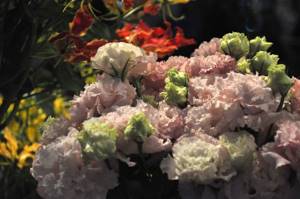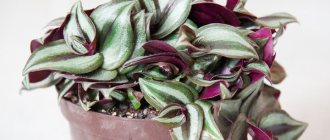Historical data
The history of lisianthus is very long, dating back to the 19th century. The native side of eustoma is the southern countries of North America. In 1806, English botanist Richard Anthony Salisbury was the first to study this flower, give it a name and classify it. However, Japanese breeders achieved great achievements in plant cultivation only in the 20th century, in the early 30s. After about 50-60 years, the “Irish rose” achieved worldwide popularity and, in terms of the scale of cultivation, it surpassed many flower crops. It is best known in America, Australia and New Zealand.
There is a legend that a long time ago a young girl refused to be the wife of the spirit of war, which is why she died. It was on her grave that these flowers first appeared.
Description
Lisianthus is a perennial, but some gardeners grow it as an annual plant. In nature there are many different flower species that attract with their beauty. Some are unpretentious and do not require much effort when growing, but some require hard work to achieve the desired result. Eustoma is just that case. Most florists are fascinated and attracted by the appearance of flowers, and accordingly they are interested in growing and caring for them.
Lisianthus - simple and elegant
The flowers of the plant are very reminiscent of unopened rose buds. They are small in size, starting from 5 cm in diameter, and are available in a wide variety of colors: from light to dark colors, and there are even two-color ones. They can also be simple or terry. Lisianthus petals seem very delicate and silky. The stem is thin and graceful, it bears many flowers that open sequentially, although there are also varieties where flowering occurs simultaneously, forming a beautiful bouquet. The leaves are distinguished by a semi-oval shape, with a waxy coating, silvery-gray or blue-green in color. Today, breeders have achieved great success in creating new varieties where the stems reach a meter in height, and the so-called potted varieties are no exception, their maximum height is about 30 cm. There are flowers that have an incredible aroma.
Growing eustoma: features
When breeding eustoma, it is important to consider many important factors.
This plant is a lover of bright, diffused light; the best soil for it would be mixed peat with bark humus.
For those who are attracted to this “beauty”, it is important to remember that it reproduces only with the help of seeds, but watering is necessary when the soil has dried at least 2 cm deep. It is not recommended to replant plants, because the roots are relatively weak and therefore are not able to adapt to new conditions. The best conditions for the plant will be a cool room with good air circulation.
Varieties and hybrids
At the moment, there are more than 60 varieties of eustoma. Lisianthus species are divided into low-growing ones, which are good for growing indoors, and tall ones, for decorating the garden. The flowers of the plant can be double and simple and have a wide variety of colors.
Garden eustoma includes the following species:
- Aurora;
- Echo;
- Heidi;
- Flamenko and others.
Indoor eustoma includes low-growing varieties - Mermaid, little Bell, Florida pink, etc. Today, not only professionals, but also amateur florists can grow it.
How to care for eustoma at home
If in the garden eustoma grows by itself and requires almost no care other than feeding, then in indoor conditions it will have to be given more attention. The plant is very demanding of lighting and fresh air, so it cannot be grown anywhere else except on a windowsill. The best place to place the Irish Rose is east or west windows. If you ventilate the room in winter, which is very important for the plant, then remove it from the windowsill - the plant absolutely does not accept drafts and cold air. The optimal temperature for Irish rose is +20-+22 degrees.
Eustoma grandiflora © HQ
Watering and humidity Regarding watering, eustoma is as capricious as a queen. Despite the fact that in nature it grows in conditions of high humidity, in room conditions the roots of the plant can rot from excess moisture. The Irish Queen should be watered with warm, settled water, and the breaks between waterings should be such that the earthen lump has time to dry completely. It is not recommended to spray eustoma during flowering. This can damage the lovely buds and leave them with unsightly rusty spots.
Replanting If you grow eustoma in a pot as an indoor perennial plant, then at one point it can grow greatly. In this case, the Irish Queen will need to be transplanted into a larger pot. If the plant feels comfortable in an old container, then this should not be done. Replanting the eustoma should be done very carefully so as not to damage the roots, so it is better to do this using the transshipment method, tilting the pot and removing the entire plant and earthen ball from it.
Feeding At the beginning of the growing season, the plant begins to be fed. Any mineral universal fertilizers are suitable for this. Next, fertilizing is applied once a week until the eustoma gains color. In the flowering state, the amount of fertilizing can be reduced.

Eustoma Voyage Sakura © Laura Blanchard
Reproduction Eustoma seeds can be bought in specialized stores. Usually there are a lot of them in a bag, since the germination of seeds in this capricious plant is not very good. The seed material of the Irish Queen is very small, but sometimes in stores you can find them in the form of granules, which is more convenient for the gardener.
Having prepared a container with light, loose soil and moistened it, the seeds are sown on the surface, lightly sprinkled with soil or sand on top. For several days, the substrate is not watered, but only covered with film and put in a warm, bright place. As soon as the soil begins to dry out, spraying will be needed. It is strictly forbidden to water it, as unrooted seeds will immediately be washed away with water.
The first eustoma shoots will appear in about 2 weeks. From this point on, the film can be removed and the container placed so that direct sunlight does not fall on the seedlings. After the first 5-6 leaves appear, young plants dive into separate pots.
In garden conditions, you can sow eustoma directly into the ground, covering it with film for the first few days. Some gardeners prefer to grow the Irish Queen in peat tablets, believing that this method is very convenient. To do this, place a seed in a softened tablet and lightly press it with your finger. After the shoots and the first few leaves appear, the plant along with peat is planted in a pot or in the ground.
Application
Due to their attractive appearance, the flowers of this plant are used to decorate bouquet arrangements; as decorations in celebration rooms; in interior design. Some of the most favorite places where you can see them are flower beds, flower beds, verandas, balconies, gardens, etc.
Composition from eustoma
Source
Irish rose (eustoma, eustoma, less commonly - eustonia) is one of the most colorful plants existing on the planet. It has an amazing color. Most often, the plant is grown at home and stands out among other home flowers. Belongs to the Gentchavkovs. Eustoma is a flower that looks like a rose, only without thorns. Translated from Latin, it literally means: “beautiful mouth”, or “beautifully speaking”. The second name of the plant is “Texas bell.” Also called lisianthus, or herbal rose. The plant has a bitter herbal taste. It was once used for medicinal purposes.
EUSTOMA (IRISH ROSE) GROWING FROM SEEDS CORRECT SOWING

VKTwitterOKYandex
video content
Rating: 4.0; Votes: 1 A very beautiful flower that is currently gaining popularity among gardeners and flower growers is Eustoma. It is also called Irish rose, Texas bluebell, beautiful mouth. This flower is difficult to distinguish from a real rose at first sight. The beauty and variety of colors of Eustoma is amazing. It is better to start sowing Eustoma in January, because this flower blooms only 5-6 months after germination. There is nothing difficult in growing Eustoma, but it is important to follow some important features that I will tell you about today. Date: 2019-08-27
← FAVORITE TOMATOES OF CHILDREN AND ADULTCHERRY ELIZABETH AND CHERRY FARMER
I WILL PLANT THIS PEPPER AGAIN IN THIS YEAR CALIFA F1 →
Related videos
The same recipe that everyone knows, but can’t find! Crispy sauerkraut
• Other Cuisine
We are on the Yenisei. Siberian fish soup on fire. Sterlet kebab. I arrived in Krasnoyarsk.
• Chef Vasily Emelianenko
Amazing RICHEST Soup made from simple ingredients. Conquers everyone from the first spoon, even gourmets.
• Cooking Recipes – Milenia
NO STERILIZATION! Without VINEGAR! WITHOUT SUGAR and without unnecessary hassles The ideal sauce for the winter that you
• Other Cuisine
THE MOST PRODUCTIVE CUCUMBERS OF 2020!
• Yield vegetable garden
THE EASIEST AND FASTEST PIE for tea! NO oven!
• Delicious moment
Comments and reviews: 10
Svetlana Makarova Hello Tatyana. I really like your advice. This year, thanks to you, I received a great harvest of all my vegetables. You are smart. But I have a question. I decided to plant eustoma. She rose on the 9th day. Now it is standing under a phyto lamp, but for some reason it is stretched upward, the distance is 20cm. Maybe I'm doing something wrong. I completely follow your advice, but maybe I'm missing something. I would be very grateful if you tell me what’s wrong.
Oksana Bondarenko Tanyusha, thank you very much for your videos - very interesting and instructive. I really like this amazing flower, but I only have to buy it in flower shops because in the Leningrad region. it cannot be grown in open ground, but in a greenhouse there are, as always, cucumbers, tomatoes, peppers) I wish you success and many more interesting videos for us gardeners and flower growers
Aliya Milovanova Tanechka, I really love any flowers, but they don’t always suit me. I am not talking about that. You are so beautiful, so smart, that I simply can’t believe that there are still people like you on planet Earth. I wish you great, great happiness. And bloom for many more years, decorate the Earth with yourself. Lipetsk.
Zinaida Sukhova Tatyana, where is your store? Are you in Moscow or St. Petersburg? I'm in St.Petersburg. Tanya, you tell everything very clearly and share your secrets. Thank you for the wonderful video tutorials.
Native weaving Please tell me, are the seeds of these lovely flowers common on sale? I haven't seen it yet. although I didn’t ask) They were very interested. Apparently it's too late to order them.
Irina Shishova Thank you Tanechka I saw on TIME that the capsule needed to be softened, last year not a single seed sprouted, but this year I sowed it again on 16.01 AND I HOPE SUNDERS WILL APPEAR
Galina Lev Tatyana, have you opened an online store selling seeds yet? I would be a buyer. Otherwise I often run into seeds that don’t germinate, but yours seems to be more reliable
Natalya Bondarenko Hello Tatyana, I always enjoy watching your videos: when planting eustoma, make a hole for air in the lid of the container
Valentina Shcherbina Thanks for the video. I also didn’t know that the capsule needed to be softened. This is a discovery for me. Thanks again for the good advice. Good luck to you
Oksana Petrichenko, some worms have appeared in my peat tablets and eaten the eustoma seedlings. In shock, I will try to transplant the remaining ones into the ground.
A little history
The herbaceous rose was discovered by Irish historian, botanist and physician Patrick Brown in the 18th century. Perennial eustoma became widespread first in European countries; later, in the 19th century, the flowers began to be grown in Russia as an ornamental house plant.
Great successes related to the cultivation of the flower were achieved in Japan in the 20th century. Half a century later, Irish rose has achieved popularity and surpassed many other flower crops. Common places of the plant are New Zealand, USA, Australia. As you can see, it’s not Ireland, which can be logically assumed based on the name.
Irish rose
There is a beautiful legend associated with the appearance of the flower: a beautiful young girl did not agree to the proposal of the spirit of war to become his wife. This became the reason for her death. Grass grew on the grave and the Irish rose first appeared here.
Description of the plant
Irish rose eustoma is a plant from the perennial group. Most gardeners use it as an annual. Due to its unusual appearance, it has attracted the attention of many florists who use the plant to create unusual compositions.
Many types of lisianthus have been created. A flower similar to the eustoma rose can be found quite often. For example, among them is the Scottish rose. Each of them is good in its own way and requires different care. Basically, the culture does not require care.
The small flowers of perennial eustoma look like rosebuds that have not yet opened. They reach only 5 cm in diameter. The colors are varied: both single-color flowers and two-color ones. Two-color buds look especially mysterious. The texture is usual smooth and terry-velvety. The petals look thin and delicate, like silk. They have a stone tint. The stem of the Irish rose is graceful and slender. Despite this, it can withstand many flowers located on it. Most often, flowers bloom in a certain sequence, one after another. Sometimes they can open together like one full bouquet. Irish rose leaves have an oval shape. They have a waxy coating of blue-green color. Breeders have gone far in creating new species of Irish rose. They easily produce more and more new specimens, the height of which reaches a meter. The exception to the rule is varieties of houseplants. Their height is about 30 cm. Some flowers have a simply amazing aroma.
Please note: there is an Icelandic rose - this is a Saintpaulia variety proposed by foreign breeders. Has nothing to do with the rose family.
Diseases
Are there dark spots on the shoots of the rose? This could be necrosis, find out how to save the plant
Bark necrosis on roses
Does the rose begin to wither and die for no apparent reason? It could be root rot, find out control and prevention measures
Root rot of roses
Girdle spots of brick and burgundy shades appear on the shoots of roses, find out why this happens
Infectious rose burn
Are there growths and cracks on the rose? It could be cancer, read what to do next
Common rose cancer
Cup-shaped double flowers, 8-10 cm in diameter, bloom in large clusters of 3-5 pieces and stay on the plant for a long time. Carved, scalloped petals (more than 50 per bud) have a heterogeneous color.
At the edges they are white-cream or light yellow, and in the center they are darker, sometimes with a lemon tint. Flowers with a strong honey-citrus aroma appear in waves on the bushes throughout the season; they tolerate heat well, but do not tolerate rain well.
USDA Hardiness Zone 6b and warmer. Requires shelter for the winter (depending on climatic conditions). But, even if after a harsh winter the stems have turned black almost to the ground, the rose recovers well and continues to bloom.
Growing, features
Irish rose is a plant that prefers diffused light. The most suitable soil is humus and peat mixed in equal proportions.
Features of Irish rose
A peculiarity of the plant is that propagation occurs exclusively by seeds. Watering is allowed only when the soil is sufficiently dry (2 cm deep into the soil).
Important! When replanting a plant you need to be extremely careful.
It's better to give it up altogether. The root system is fragile and prone to damage. The optimal maintenance condition is a cool room with free flow of air.
Bred varieties and hybrids
To date, more than 60 varieties of Irish rose have already been bred. All of them are divided into small in stature - short and tall. The former are used for keeping at home, the latter - in open areas, in garden conditions. In both cases, eustonia looks wonderful; perennial flowers are a worthy decoration of the space. The texture of the flowers can be either double or regular. Coloring in the most unimaginable shades.
Garden eustoma - varieties: Aurora, Echo, Heidi, Flamenko and others.
Indoor varieties: Mermaid, Little bell, Florida pink, etc.
Indoor varieties
Previously, only professionals were engaged in cultivation. Now even an amateur gardener can do this.
Eustoma (lisianthus): 65 photos, care and cultivation
The southern origin of Texas bluebells is the reason for the rather capricious behavior of these flowers in temperate climates. After all, summer at the equator lasts almost all year round, which means that for normal development, eustoma will have to be provided with bright artificial lighting and comfortable warmth.
Lisianthus is grown in only one way - seedlings from seeds, and the cycle must begin no later than January. From the emergence of seedlings to the beginning of flowering, at least 20 weeks pass, that is, 5–6 months, and the germination of microscopic grains itself requires at least 20–30 days. Eustoma cannot be propagated vegetatively, so dividing an adult bush or rooting a cutting is unlikely.
It is recommended to sow Irish rose seeds 1-2 pieces in separate cassettes, plastic cups or peat tablets. A plastic container with a transparent lid would also be a good option - it can easily create a greenhouse effect. The optimal substrate for future seedlings is light turf soil with the addition of river sand, and from ready-made mixtures you can choose soil for indoor violets (Saintpaulias). The soil should be well moistened with warm water, then the grains should be deepened into it by 2–3 mm, the containers should be tightly covered with a transparent lid or polyethylene and left at +20…+25C for germination. Additional light is not needed at this time, the main thing is warmth and constant moderate humidity.
When green shoots appear, the eustoma should be placed under a fluorescent lamp, otherwise the shoots will stretch out and turn yellow. All this time, it is important to regularly water them with water at room temperature and gradually open the film so that air can penetrate into the 'greenhouses'. Around the beginning of spring (March-April), two-month-old plants are planted one at a time into separate pots, where there must be good drainage and nutritious turf-chernozem soil with sand. It is impossible to expose tender seedlings to direct sunlight, but diffused daylight near a south window or on a warm balcony will only benefit it.
Low-growing indoor varieties of lisianthus are left to bloom on the windowsill, while garden varieties are transplanted into open ground only after the threat of frost has completely passed - it all depends on the climate in a particular region. The site for these flowers should be sunny and quiet, protected from the wind, with moderately moist black soil. For the first week or two after planting, seedlings should be covered with halves of plastic bottles with open caps - for adaptation and protection from the night cold. In tall varieties, after 6–7 pairs of leaves, the central stem is pinched so that more lateral shoots are formed and the bush looks more voluminous. If everything is done correctly, you can admire lush bouquets of Irish roses for 2-3 months – from July-August to October.
Irish rose from seeds
To grow eustoma at home, you need to be patient and spend a lot of time and effort. Here it is important to master all the intricacies of the growing and care process. If you take this seriously and responsibly, the result can be simply amazing, exceeding all expectations. Since the plant is becoming more and more in demand every year among flower growers and florists, this can very well become a profitable business. The difficulty in sowing lies in the small size of the seeds. 23 thousand pieces are only 1 gram.
The planting scheme is as follows: seeds should be sown in late winter - early spring. The soil requires sterile, fertilized with some nitrogen. It is necessary to pour the seeds onto a plate, cover the top with glass so that fresh air reaches them. Artificial lighting must be used so that the daylight hours are 10-12 hours. The temperature should be about 20 degrees. You can not water the future plant for 60 days. The first shoots are visible after a couple of weeks. It is worth removing the glass and spraying them with a phytosporin solution. Transplant into a larger container only when leaves appear. After three months, the plants are transferred to open soil.
Rose seeds
The most important thing for growing Irish roses - eustoma at home
- Seeds should be sown 6 months before expected flowering.
- The flower is very picky about temperature, its value: -not lower than 25 degrees for seed germination; -not lower than 20 degrees for the formation of buds.
- The duration of daylight for both seedlings and flowering plants should be at least 10 hours.
- Watering is necessary regularly, when the top layer of soil dries 2 cm.
- Be sure to add calcium and potassium to the fertilizer.
Eustoma from “A” to “Z” - a complete guide to growing:
Irish rose in the apartment
The home is a great place to grow the plant. If you want to see flowering in winter, you need to sow the seeds in advance - in the summer. You need a large container filled with soil. Soil composition: sand and peat, in equal proportions. It is enough to scatter the seeds on the surface and cover with film or glass. It is necessary to provide a sufficient amount of light, as well as the optimal temperature - 20 degrees. If necessary, spray the seeds. After 21 days, the results of seed care should appear.
It is necessary to plant in separate containers when the first green leaves appear.
Features of growing a flower from seeds
Seeds are planted from February to August. Flowering occurs after 6 months. When growing at home, you can use any soil purchased in the store.
- Place the soil in a cup.
- Compact and moisten with water.
- Take 5 seeds and lightly bury them in the soil using a toothpick.
- Cover with film and place near the battery.
- Every day it is necessary to ventilate; to do this, open the film slightly for a couple of minutes.
- Occasionally spray with warm water.
- After 14 days, the seeds will hatch.
- After they grow, the film is removed.
- Watering is done as the soil dries.
- Mineral fertilizers are applied.
A month later, the eustoma is transplanted into plastic pots. In May you can put them on the veranda.
The plant does not tolerate direct sunlight, so it must be covered and sprayed during the hot period. Liquid fertilizers are applied weekly.
Plant care
After planting the plants in pots, they should be given proper care. First of all, a sufficient amount of sunlight, you can also use artificial light. The room must be ventilated, without drafts. Watering is carried out only with soft, settled water. When watering, it is necessary to observe the measure: do not allow the soil to dry out or become waterlogged. If the soil is too wet, the roots may begin to rot and the plant will die. No need to spray. During flowering, it is necessary to apply fertilizer in a timely manner.
Fertilizer for roses
After flowering
An indoor rose should be trimmed after flowering, leaving two or three internodes. In this state, the plant requires rest. Room temperature +15 degrees. Minimal watering is required and there is no need for fertilizer. When shoots appear, transplant them into new soil.
When the garden eustoma has bloomed, it can be transplanted into a pot, placing it on the balcony or in the apartment. It also requires a period of rest. Caring for a garden plant at home is the same as caring for a houseplant.
Irish rose or eustoma at home
The Irish rose or eustoma, which we will look at at home care in this article, looks like a queen among other indoor flowers. This plant is from the Gentian family, native to Central America, prefers warm and humid air.
Eustoma - growing at home. Description, varieties, features
The shape of lisianthus flowers (another name for this plant) resembles the flowers of an ordinary rose. They have a wide variety of colors, they can be both simple and terry. Lisianthus leaves are gray, elliptical in shape, covered with a waxy coating. The height of most varieties of eustoma is from fifty to seventy centimeters. There are also lower ones - they are well suited for growing in pots. Eustoma at home is now available not only to professionals; its seeds can be purchased by any amateur gardener. Already grown flowering plants in pots are also sold. Thanks to breeders, there are many varieties of lisianthus.
Flower care: required temperature, soil, watering regime
In winter, lisianthus tolerates cool rooms well. During the period of bud formation, the temperature should be at least twenty degrees Celsius. Then the plant will form the maximum number of flowers. Do not use large pots, otherwise the lisianthus will produce a huge number of leaves and may not bloom. When replanting, place a layer of drainage on the bottom. The soil should be peaty, similar to Saintpaulia substrate, and fairly light. You can add pieces of charcoal. The watering regime must be maintained in such a way that the substrate never dries out completely. However, there is no need to flood the plant. Use your finger to control the drying of the top layer of soil. You should not immerse the container with lisianthus in water - water only from the top of the pot. When the plant blooms or when the air temperature is warm, you can slightly increase the amount of moisture.










